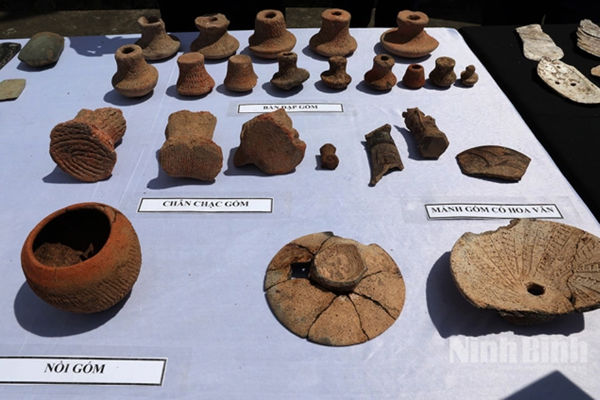The information was released by the provincial Department of Sport and Culture on June 24 after two months of excavation.
According to a preliminary report, archaeologists unearthed stone working tools, ceramics, bones and mollusc shells at the archaeological site in Bach Lien village, in Yen Mo district.
One of the important findings is a set of tools made from oyster shells, pieces of jade (which function as ornaments) made from mollusk shells and fragments that may be “nha chuong”.
“Nha chuong” is a finely crafted stone artifact, often shaped like a sword or short knife, with grooves, holes and polished to a smooth finish. “Nha chuong” is considered a symbol of power of ancient leaders, and can also be a type of sacrificial instrument in ancient rituals.
Historians believe that the set of relics found shows a rich material and spiritual life, reflecting the inter-regional cultural relationships of ancient Man Bac residents.
Based on the results of previous excavations and this excavation, scientists affirm that Man Bac is a special residential-burial relic. Man Bac residents were aware of their own burial area even though it was still located next to their residences. The density of burials found is dense in the western area, while the eastern area mainly concentrates on residential traces.
From the excavation results at Man Bac, the archaeological team proposed keeping the natural landscape around the relic intact, aiming to build an archaeological park. Ninh Binh province also promoted the construction of a dossier to propose the ranking of a national relic for the Man Bac relic.
The Man Bac archaeological relic, located in Yen Thanh commune, Yen Mo district, is assessed by experts as one of the most typical and intact pre-Dong Son relics in Northern Vietnam.
Discovered in 1998 and excavated many times with the cooperation of international experts, Man Bac dates back about 3,500-4,000 years, belonging to the Phung Nguyen culture.
The relic includes a residential area and more than 100 burials, showing that residents of this period had a separate social organisation, burial customs and a fairly developed spiritual life.
Thousands of artifacts have been found here such as pottery, stone tools, animal bones and human remains. These documents have provided valuable resources for research on manufacturing techniques, burial customs as well as health status of ancient Vietnamese people.
The relic has been ranked at the provincial level, with the orientation of building an archaeological park and an outdoor museum to serve research and tourism.










